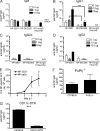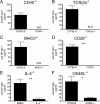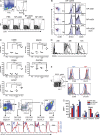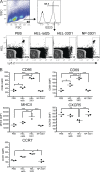Extrafollicular B cell activation by marginal zone dendritic cells drives T cell-dependent antibody responses
- PMID: 22966002
- PMCID: PMC3457737
- DOI: 10.1084/jem.20120774
Extrafollicular B cell activation by marginal zone dendritic cells drives T cell-dependent antibody responses
Abstract
Dendritic cells (DCs) are best known for their ability to activate naive T cells, and emerging evidence suggests that distinct DC subsets induce specialized T cell responses. However, little is known concerning the role of DC subsets in the initiation of B cell responses. We report that antigen (Ag) delivery to DC-inhibitory receptor 2 (DCIR2) found on marginal zone (MZ)-associated CD8α(-) DCs in mice leads to robust class-switched antibody (Ab) responses to a T cell-dependent (TD) Ag. DCIR2(+) DCs induced rapid up-regulation of multiple B cell activation markers and changes in chemokine receptor expression, resulting in accumulation of Ag-specific B cells within extrafollicular splenic bridging channels as early as 24 h after immunization. Ag-specific B cells primed by DCIR2(+) DCs were remarkably efficient at driving naive CD4 T cell proliferation, yet DCIR2-induced responses failed to form germinal centers or undergo affinity maturation of serum Ab unless toll-like receptor (TLR) 7 or TLR9 agonists were included at the time of immunization. These results demonstrate DCIR2(+) DCs have a unique capacity to initiate extrafollicular B cell responses to TD Ag, and thus define a novel division of labor among splenic DC subsets for B cell activation during humoral immune responses.
Figures










Similar articles
-
Targeting antigens to CD180 rapidly induces antigen-specific IgG, affinity maturation, and immunological memory.J Exp Med. 2013 Sep 23;210(10):2135-46. doi: 10.1084/jem.20130188. Epub 2013 Sep 9. J Exp Med. 2013. PMID: 24019553 Free PMC article.
-
Toll-like receptor 7 controls the anti-retroviral germinal center response.PLoS Pathog. 2011 Oct;7(10):e1002293. doi: 10.1371/journal.ppat.1002293. Epub 2011 Oct 6. PLoS Pathog. 2011. PMID: 21998589 Free PMC article.
-
The role of B cell antigen presentation in the initiation of CD4+ T cell response.Immunol Rev. 2020 Jul;296(1):24-35. doi: 10.1111/imr.12859. Epub 2020 Apr 18. Immunol Rev. 2020. PMID: 32304104 Review.
-
Endogenous dendritic cells are required for amplification of T cell responses induced by dendritic cell vaccines in vivo.J Immunol. 2003 Mar 15;170(6):2817-23. doi: 10.4049/jimmunol.170.6.2817. J Immunol. 2003. PMID: 12626531
-
Contribution of Toll-like receptor signaling to germinal center antibody responses.Immunol Rev. 2012 May;247(1):64-72. doi: 10.1111/j.1600-065X.2012.01115.x. Immunol Rev. 2012. PMID: 22500832 Free PMC article. Review.
Cited by
-
PIK3IP1 Promotes Extrafollicular Class Switching in T-Dependent Immune Responses.J Immunol. 2020 Oct 15;205(8):2100-2108. doi: 10.4049/jimmunol.2000584. Epub 2020 Sep 4. J Immunol. 2020. PMID: 32887751 Free PMC article.
-
Targeting Antigens to CD180 but Not CD40 Programs Immature and Mature B Cell Subsets to Become Efficient APCs.J Immunol. 2019 Oct 1;203(7):1715-1729. doi: 10.4049/jimmunol.1900549. Epub 2019 Sep 4. J Immunol. 2019. PMID: 31484732 Free PMC article.
-
Controlling immune responses by targeting antigens to dendritic cell subsets and B cells.Int Immunol. 2014 Jan;26(1):3-11. doi: 10.1093/intimm/dxt059. Epub 2013 Nov 27. Int Immunol. 2014. PMID: 24285828 Free PMC article. Review.
-
Atypical chemokine receptor 4 shapes activated B cell fate.J Exp Med. 2018 Mar 5;215(3):801-813. doi: 10.1084/jem.20171067. Epub 2018 Jan 31. J Exp Med. 2018. PMID: 29386231 Free PMC article.
-
Experimental Stroke Differentially Affects Discrete Subpopulations of Splenic Macrophages.Front Immunol. 2018 May 22;9:1108. doi: 10.3389/fimmu.2018.01108. eCollection 2018. Front Immunol. 2018. PMID: 29872438 Free PMC article.
References
-
- Berney C., Herren S., Power C.A., Gordon S., Martinez-Pomares L., Kosco-Vilbois M.H. 1999. A member of the dendritic cell family that enters B cell follicles and stimulates primary antibody responses identified by a mannose receptor fusion protein. J. Exp. Med. 190:851–860 10.1084/jem.190.6.851 - DOI - PMC - PubMed
Publication types
MeSH terms
Substances
Grants and funding
LinkOut - more resources
Full Text Sources
Other Literature Sources
Molecular Biology Databases
Research Materials

